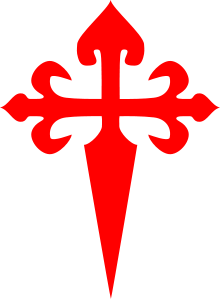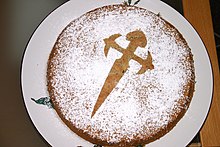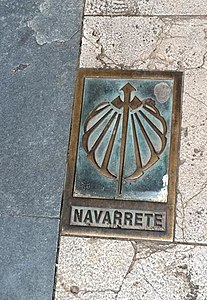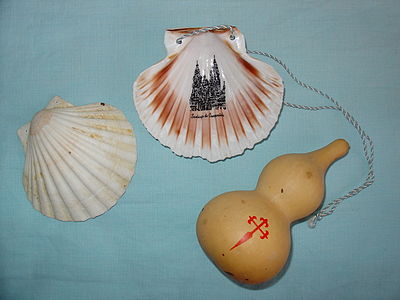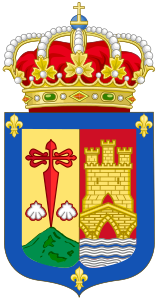
Santiago de Compostela, simply Santiago, or Compostela, is the capital of the autonomous community of Galicia, in northwestern Spain. The city has its origin in the shrine of Saint James the Great, now the Cathedral of Santiago de Compostela, as the destination of the Way of St. James, a leading Catholic pilgrimage route since the 9th century. In 1985, the city's Old Town was designated a UNESCO World Heritage Site.
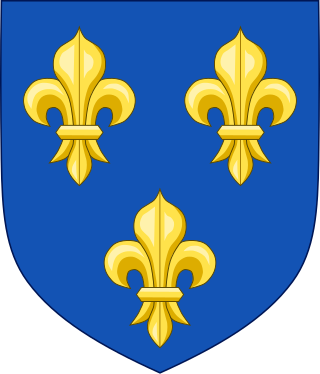
The fleur-de-lis, also spelled fleur-de-lys, is a common heraldic charge in the shape of a lily. Most notably, the fleur-de-lis is depicted on the traditional coat of arms of France that was used from the High Middle Ages until the French Revolution in 1792, and then again in brief periods in the 19th century. This design still represents France and the House of Bourbon in the form of marshalling in the arms of Spain, Quebec and Canada, for example.

James the Great was one of the Twelve Apostles of Jesus. According to the New Testament, he was the second of the apostles to die, and the first to be martyred. Saint James is the patron saint of Spain and, according to tradition, his remains are held in Santiago de Compostela in Galicia.
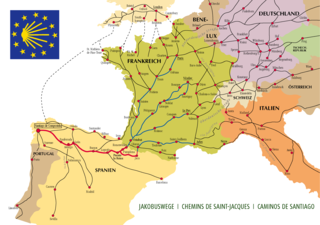
The Camino de Santiago, or in English the Way of St. James, is a network of pilgrims' ways or pilgrimages leading to the shrine of the apostle James in the cathedral of Santiago de Compostela in Galicia in northwestern Spain, where tradition holds that the remains of the apostle are buried.

In heraldry, a charge is any emblem or device occupying the field of an escutcheon (shield). That may be a geometric design or a symbolic representation of a person, animal, plant, object, building, or other device. In French blazon, the ordinaries are called pièces, and other charges are called meubles.

Tui is a municipality in the province of Pontevedra, in the autonomous community of Galicia, Spain. It is located in the comarca of O Baixo Miño on the right bank of the Miño River, facing the Portuguese town of Valença. The municipality of Tui is composed of 11 parishes: Randufe, Malvas, Pexegueiro, Areas, Pazos de Reis, Rebordáns, Ribadelouro, Guillarei, Paramos, Baldráns and Caldelas.

The Order of Santiago is a religious and military order founded in the 12th century. It owes its name to the patron saint of Spain, Santiago. Its initial objective was to protect the pilgrims on the Way of St. James, to defend Christendom and to remove the Muslim Moors from the Iberian Peninsula with the Reconquista. Entrance was not restricted to nobility of Spain exclusively, and some members have been Catholic Europeans from other parts of Europe. The Order's insignia is particularly recognisable and abundant in Western art.

The Camino de Santiago, also known as the Way of St. James, extends from different countries of Europe, and even North Africa, on its way to Santiago de Compostela and Finisterre. The local authorities try to restore many of the ancient routes, even those used in a limited period, in the interest of tourism.

The Spanish autonomous community and province of La Rioja has a coat of arms, which was assigned to the former province of Logroño in 1957, and to the present autonomous community on its foundation in 1982. It consists of a shield which is divided vertically into two halves, featuring respectively the Cross of Saint James and a castle, and is surmounted by a royal crown. Also depicted are Monte Laturce and the Ebro river.

The Battle of Clavijo is a mythical battle, believed for centuries to be historical, which became a popular theme of Spanish traditions regarding the Christian expulsion of the Muslims. Stories about the battle first arose centuries after it allegedly occurred; according to these stories, it was fought near Clavijo between Christians led by Ramiro I of Asturias and Muslims led by the Emir of Córdoba.The Diccionario de historia de España (1968) says: "To a serious historian, the existence of the Battle of Clavijo is not even a topic of discussion."

Torta de Santiago or Tarta de Santiago, literally meaning cake of St. James, is an almond cake or pie from Galicia with its origin in the Middle Ages and the Camino de Santiago. The ingredients mainly consist of ground almonds, eggs, and sugar, with additional flavouring of lemon zest, sweet wine, brandy, or grape marc, depending on the recipe used.

The French Way follows the GR 65 and is the most popular of the routes of the Way of St. James, the ancient pilgrimage route to Santiago de Compostela in Galicia, Spain. It runs from Saint-Jean-Pied-de-Port on the French side of the Pyrenees to Roncesvalles on the Spanish side and then another 780 km on to Santiago de Compostela through the major cities of Pamplona, Logroño, Burgos and León. A typical walk on the Camino francés takes at least four weeks, allowing for one or two rest days on the way. Some travel the Camino on bicycle or on horseback.
The Royal Equestrian and Military Order of Saint Michael of the Wing is a Portuguese Roman Catholic dynastic order that is believed to have been founded in 1147 in the Alcobaça Monastery in Alcobaça, Portugal, by King Afonso I of Portugal, in commemoration of the Conquest of Santarém from the Moors in 1147. The name was chosen in honour of the military Saint Archangel Michael, who assisted in the victory in the shape of a wing in the sky.

Saint James the Moor-slayer is the name given to the representation of the apostle James the Great, as a legendary, miraculous figure who appeared at the also legendary Battle of Clavijo, helping the Christians conquer the Muslim Moors.

Jessant-de-lys is a heraldic term denoting a fleur-de-lys issuing out of any object. It is most frequently seen in conjunction with a leopard's face, meaning in heraldic language the face of a lion.
The Voto de Santiago was an offering rendered by the Christian kingdoms of Asturias, Galicia, León and Castille to Saint James and his cathedral at Santiago de Compostella in thanks for the saint's miraculous intervention, which they believed had enabled them to win the legendary battle of Clavijo against the Moors. The battle had resulted from his refusal to pay the Tribute of 100 Damsels to the Emirate of Córdoba.

The Ourense Cathedral is a Roman Catholic church located in Ourense in Galicia. Dedicated to St Martin, it was founded in 550. The first structure was restored by Alonso el Casto. The present mainly Gothic building was raised with the support of Bishop Lorenzo in 1220. Its local patroness is Saint Euphemia. There is a silver-plated shrine, and others of St Facundus and St Primitivus. The Christ's Chapel was added in 1567 by Bishop San Francisco Triccio. It contains an image of Christ, which was brought in 1330 from a small church on Cape Finisterre. John the Baptist's Chapel was created in 1468 by the Conde de Benavente. The Portal of Paradise is sculptured and enriched with figures of angels and saints, while the antique cloisters were erected in 1204 by Bishop Ederonio. The Capilla de la Maria Madre was restored in 1722, and connected by the cloisters with the cathedral. The eight canons were called Cardenales, as at the Cathedral of Santiago de Compostela, and they alone did services before the altar; this custom was recognised as "immemorial" by Pope Innocent III, in 1209. The cathedral, which has undergone an impressive transition of architectural styles of Romanesque, Gothic, Renaissance, Baroque and Neoclassical, was built to a Latin Cross plan. It has been a functional basilica since 1887. The cathedral has a crucifix that is held in great reverence all over Galicia.

The coat of arms of the London Borough of Croydon is the official heraldic arms of the London Borough of Croydon, granted on 10 December 1965.

The Plaza de las Cinco Calles is a square of medieval origin located in the heart of the historic centre of the city of Pontevedra (Spain).

The coat of arms of Santiago de Compostela represents Santiago de Compostela, in the province of A Coruña, Galicia, Spain. The coat of arms combines Galician heraldry with traditions related to the city of Santiago de Compostela.
